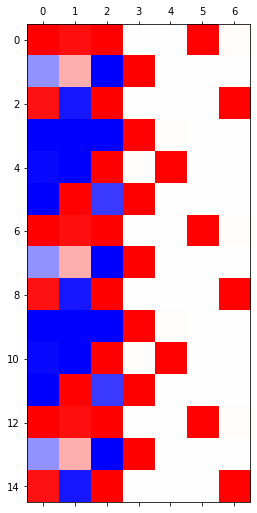import torch
import numpy as np
import matplotlib.pyplot as plt11wk-1: 순환신경망 (4)
순환신경망
RNN (2)– AbAcAd예제(3)
강의영상
https://youtube.com/playlist?list=PLQqh36zP38-zRWSBjuvzsjPe6JxnHO4AX
import
Define some funtions
def f(txt,mapping):
return [mapping[key] for key in txt]
soft = torch.nn.Softmax(dim=1)Exam4: AbAcAd (3)
data
- 기존의 정리방식
txt = list('AbAcAd')*100
txt[:10]['A', 'b', 'A', 'c', 'A', 'd', 'A', 'b', 'A', 'c']txt_x = txt[:-1]
txt_y = txt[1:]txt_x[:5],txt_y[:5](['A', 'b', 'A', 'c', 'A'], ['b', 'A', 'c', 'A', 'd'])x = torch.nn.functional.one_hot(torch.tensor(f(txt_x,{'A':0,'b':1,'c':2,'d':3}))).float()
y = torch.nn.functional.one_hot(torch.tensor(f(txt_y,{'A':0,'b':1,'c':2,'d':3}))).float()x,y(tensor([[1., 0., 0., 0.],
[0., 1., 0., 0.],
[1., 0., 0., 0.],
...,
[1., 0., 0., 0.],
[0., 0., 1., 0.],
[1., 0., 0., 0.]]),
tensor([[0., 1., 0., 0.],
[1., 0., 0., 0.],
[0., 0., 1., 0.],
...,
[0., 0., 1., 0.],
[1., 0., 0., 0.],
[0., 0., 0., 1.]]))HW: hello 예제
아래와 같이 hello가 반복되는 자료가 있다고 하자.
txt = list('hello')*100
txt[:10]['h', 'e', 'l', 'l', 'o', 'h', 'e', 'l', 'l', 'o']txt_x = txt[:-1]
txt_y = txt[1:]txt_x[:5],txt_y[:5](['h', 'e', 'l', 'l', 'o'], ['e', 'l', 'l', 'o', 'h'])x = torch.nn.functional.one_hot(torch.tensor(f(txt_x,{'h':0,'e':1,'l':2,'o':3}))).float()
y = torch.nn.functional.one_hot(torch.tensor(f(txt_y,{'h':0,'e':1,'l':2,'o':3}))).float()x,y(tensor([[1., 0., 0., 0.],
[0., 1., 0., 0.],
[0., 0., 1., 0.],
...,
[0., 1., 0., 0.],
[0., 0., 1., 0.],
[0., 0., 1., 0.]]),
tensor([[0., 1., 0., 0.],
[0., 0., 1., 0.],
[0., 0., 1., 0.],
...,
[0., 0., 1., 0.],
[0., 0., 1., 0.],
[0., 0., 0., 1.]]))3개의 은닉노드를 가진 RNN을 설계하고 학습시켜라.






